Women's headbands in the 1920s became crucial fashion accessories, embodying the flapper spirit. You'd find them decorated with rhinestones, faux pearls, and feathers, often accentuating the newfound bobbed hairstyles. These headbands were handmade, allowing for customization that reflected personal style and individuality. Their extravagant designs drew inspiration from Art Deco, emphasizing geometric shapes and bold embellishments, which were indispensable for evening events. While simpler hairstyles later diminished their popularity, the headbands' unique craftsmanship and flair left a lasting impression on fashion. Explore how this trend influenced modern interpretations and continued to inspire contemporary styles.
Evolution of Headbands in the 1920s
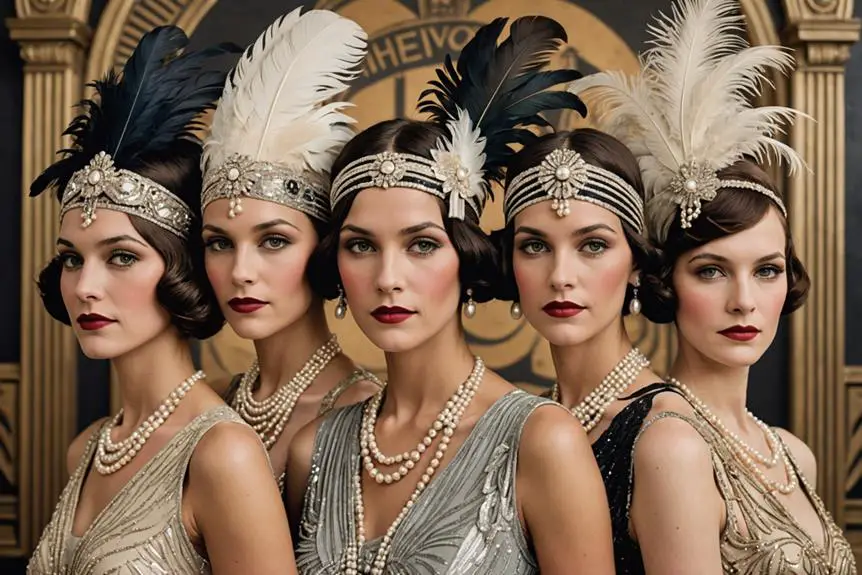
During the vibrant 1920s, headbands evolved into essential evening accessories that transformed the way women expressed their style. As the flapper movement took center stage, these headpieces became synonymous with the bold, liberated spirit of the Roaring Twenties. The era's fashion was characterized by opulence, and headbands often featured intricate embellishments like rhinestones, faux pearls, and lace, reflecting the lavishness of the Great Gatsby lifestyle. Vintage clothing from this time period often showcased unique design elements and craftsmanship, with accessories serving as a key identifier of a woman's fashion statement, including common vintage labels.
Handmade headbands emerged as a creative outlet, allowing you to customize your accessories for special occasions or daily wear. Early in the decade, decorative elements like peacock and white egret feathers adorned these vintage headbands, offering an extravagant flair that captivated attention. The art deco influence infused geometric shapes and patterns into designs, further enhancing their appeal.
However, as the decade progressed, the popularity of headbands began to wane. Short hairstyles prompted a shift toward simpler accessories, such as ribbons and feathers, marking a change in women's fashion. Despite this decline, the evolution of headbands during the 1920s remains a demonstration of a transformative era in style, capturing the essence of a time that celebrated individuality and creativity.
Iconic Flapper Headband Designs
As headbands became a prominent feature of women's fashion in the 1920s, iconic flapper designs emerged that epitomized the era's spirit. These accessories weren't just decorative; they were bold statements of liberation and style. The vibrant colors and unique designs drew inspiration from various cultural influences, similar to the trendy styles of vintage clothing that celebrated individuality. Here are four key elements that defined these stunning flapper headbands:
- Extravagant Materials: From rhinestones to beads, flapper headbands sparkled with opulence.
- Feathers and Beads: Many designs showcased peacock feathers or intricate beadwork, enhancing the wearer's allure.
- Art Deco Inspiration: The geometric shapes and lavish embellishments reflected the Deco Flapper style, seamlessly blending with other fashion trends of the time.
- Cultural Symbols: These headbands became essential for women attending jazz clubs, signifying a shift in societal norms.
You'd typically see a Flapper Headband worn across the forehead, accentuating the trendy bobbed hairstyles. The Great Gatsby headpiece often featured striking black and gold tones or a vintage-inspired feather headpiece, while beaded headbands added a touch of glam. With such variety, each 1920s headpiece became a representation of the vibrant, transformative energy of the Roaring Twenties, making it clear that fashion was a language of its own.
Materials and Craftsmanship
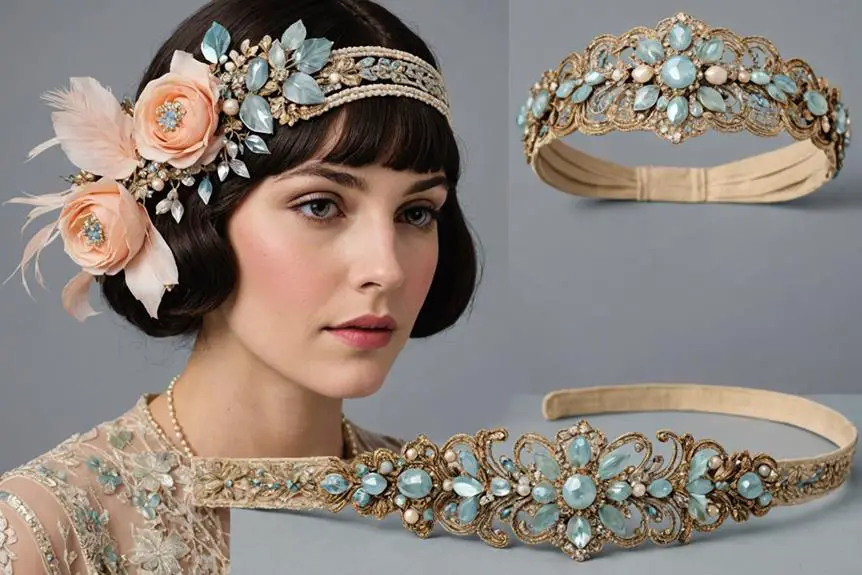
Headbands in the 1920s were not just fashion accessories; they were crafted masterpieces that combined luxury and artistry. You'd find these pieces made from sumptuous materials like satin, silk, and velvet, ensuring both elegance and comfort for evening wear. The tactile quality of these fabrics contributed to the overall allure, making the headbands desirable for the stylish flapper.
Intricate beadwork and sparkling rhinestones adorned many designs, meticulously hand-sewn to create stunning visual effects. Faux pearls added a touch of opulence, while feathers—especially peacock and white egret—enhanced the dramatic flair that defined the era. These embellishments weren't merely decorative; they showcased the skill and creativity of the artisans who crafted them.
Unique craftsmanship techniques like embroidery and lacework were also prevalent, further highlighting the artistry behind each piece. As the popularity of headbands surged, many artisans embraced handmade creations, allowing for custom designs that reflected individual style. This emphasis on artistry and detail exemplified the spirit of the Roaring Twenties, making headbands a symbol of both fashion and cultural identity during this vibrant decade.
Styling Tips for 1920s Headbands
For anyone looking to embrace the bold elegance of 1920s fashion, mastering the art of styling headbands is essential. These vintage headpieces are perfect for complementing your flapper outfits and enhancing your evening attire. Understanding the historical context of vintage clothing labels can also elevate your overall look, as it allows you to select pieces that truly resonate with the era. Here are some styling tips to help you shine like Gatsby:
- Positioning: Wear your 1920s headband across your forehead or crown for a versatile look that complements bobbed hairstyles.
- Material Choices: Opt for rhinestone headbands for a glamorous touch or feather headbands to add drama and flair to your ensemble.
- Accessorizing: Pair your headband with silk or satin ribbons tied in bows to emphasize simplicity while maintaining sophistication in your evening outfits.
- Layering: Don't hesitate to layer different headbands, mixing beaded and feather designs to create a unique and eye-catching effect.
Modern Interpretations of 1920s Styles
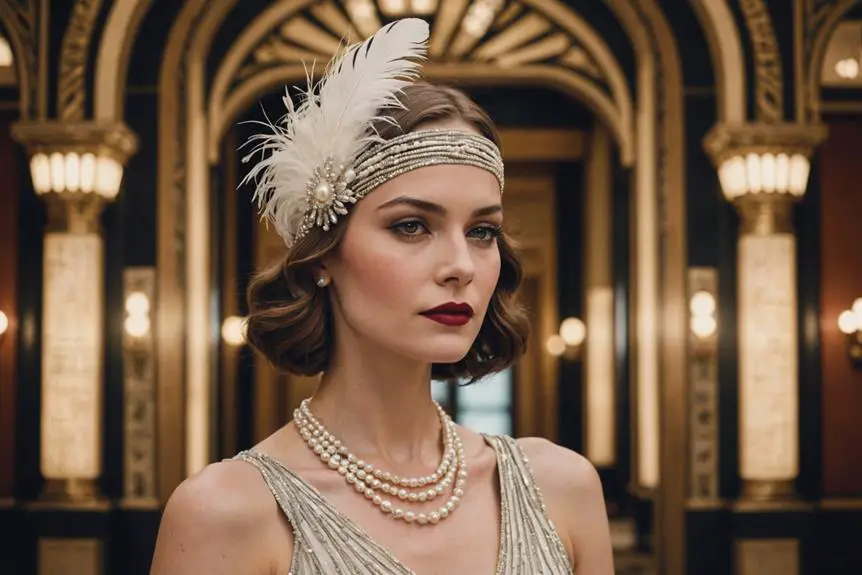
The allure of the 1920s continues to inspire modern fashion, particularly through the revival of headband styles that capture the essence of the roaring twenties. You'll find that modern interpretations of flapper headbands often incorporate authentic design elements like beads, rhinestones, and feathers, reflecting the glamour of the Deco era. These accessories, including the popular Gatsby headband, are designed with stretchy bands for comfort while maintaining that timeless vintage charm.
Today's headbands, priced affordably between $16.95 and $19.95, make it easy to channel your inner flapper. You can explore various styles, from the elegant Silver Flapper to the striking Black Feather Headband, all of which evoke the spirited essence of the Roaring 20s. Craftsmanship in these pieces emphasizes classic materials like sequins and faux pearls, enhancing their elegance and appeal.
For those who appreciate vintage fashion, platforms like Etsy offer a treasure trove of handmade accessories sets, promoting individuality and creativity in modern adaptations of 1920s styles. With these options, you can effortlessly incorporate the allure of the past into your contemporary wardrobe.
Frequently Asked Questions
What Are the 1920S Headbands Called?
The headbands from that era are often referred to as flapper headbands. You'll find they were adorned with beads, feathers, and lace, embodying the lavish spirit of the Roaring Twenties and complementing iconic hairstyles.
How to Wear a 1920S Headband?
To wear a headband effectively, position it across your forehead or above your hairline. Choose embellishments like beads or feathers, and pair it with a bobbed hairstyle for a chic, vintage-inspired look.
What Are Headache Bands 1920?
Headache bands from the 1920s are stylish accessories designed to enhance your look while offering comfort. They feature elastic materials and embellishments like beads and rhinestones, reflecting the era's opulence and adding glamour to your outfits.
What Did Women's Hair Look Like in the 1920s?
In the 1920s, you'd see women sporting chic bob cuts, often styled with finger waves or shingle bobs. These hairstyles emphasized elegance, perfect for the era's vibrant, social atmosphere and evolving fashion trends.
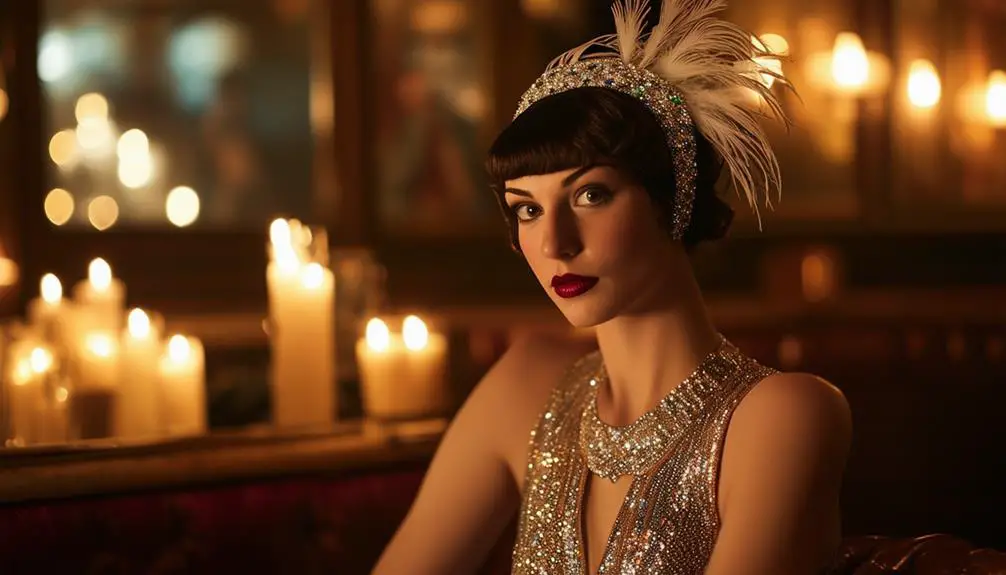

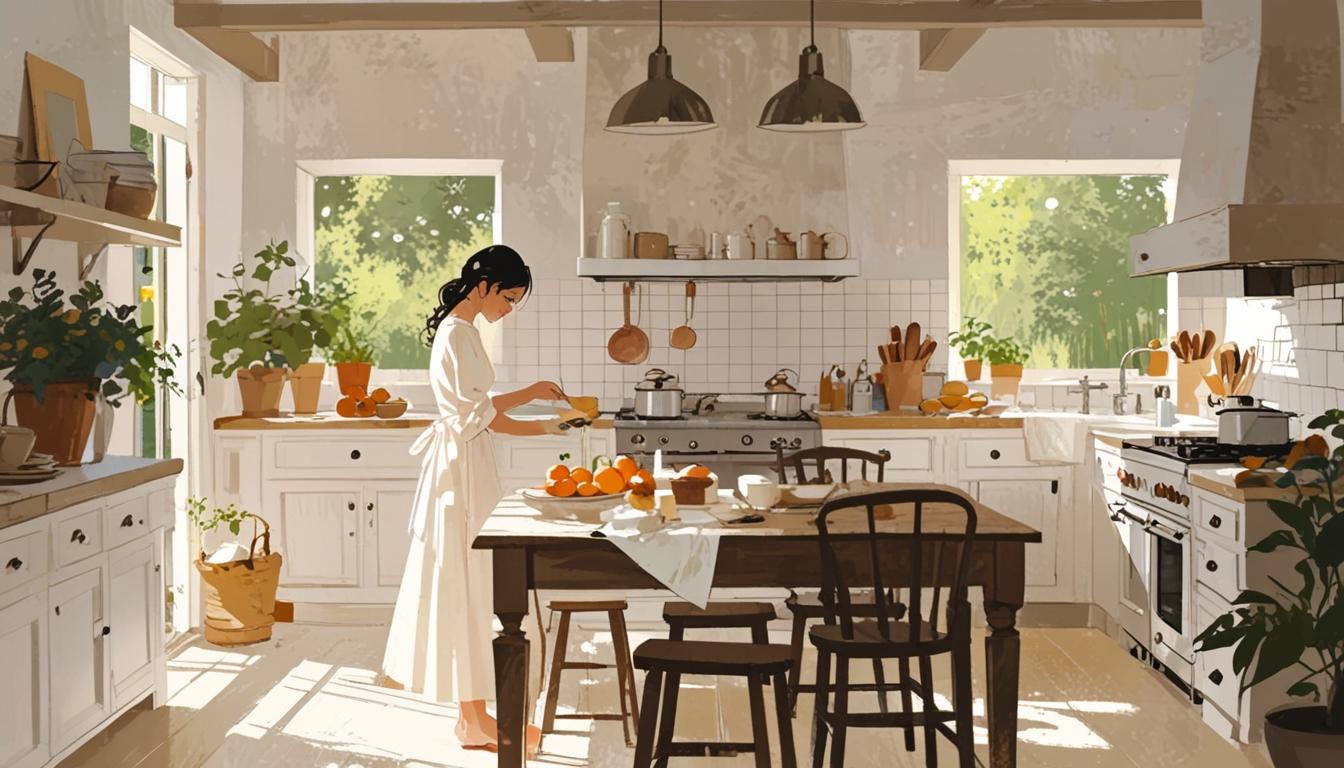
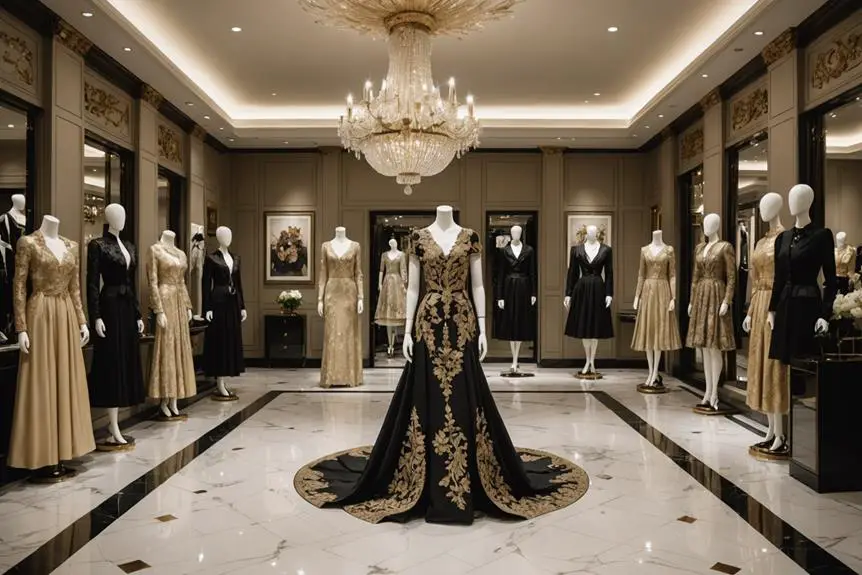

Thank you for your sharing. I am worried that I lack creative ideas. It is your article that makes me full of hope. Thank you. But, I have a question, can you help me?